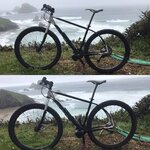JRA
Well-Known Member
Pieced together a TSDZ2 running OS software on an OS Blackbuck hardtail.
48v/18Ah/21700 cell HL type battery
Advent 9spd drivetrain 11/42
Hayes Trail brakes
750d/40c Nanoraptors/Handbuilt wheels with generic hubs and 311mm spokes...
WTB headset and saddle
Ti post I had kicking around....thought I had a bar/stem in stock but ended up having to do a trip to the big city to get one at a friends shop and as luck would have it it actually is the right combo...
25 zip ties, assorted colors
Installation time included building the wheels and from frame up. I started assembling parts from all over 3 weeks ago and took it out for a shakedown cruise today.

Initial impression is that this is a fast bike and likes pavé and gravel just fine which is what I wanted for where I am living. The chainline is as usual out too far for the lower gears but I have a fix for that using an offset chainring like I did on my TSDZ2 eMTB. I don't have a scale so I don't know what it weighs other than it is alot lighter without the battery on. But riding it is not affected at all and even though it is a rigid bike it is pretty comfortable.
I ran 33psi with tubes off the stand and didn't feel like they needed to be any more or less. I taped the rims and will be converting to tubeless for the security I have become used to and I feel a more supple ride quality.
Needs a few tweaks here and there and then more testing needed which is the good part.
48v/18Ah/21700 cell HL type battery
Advent 9spd drivetrain 11/42
Hayes Trail brakes
750d/40c Nanoraptors/Handbuilt wheels with generic hubs and 311mm spokes...
WTB headset and saddle
Ti post I had kicking around....thought I had a bar/stem in stock but ended up having to do a trip to the big city to get one at a friends shop and as luck would have it it actually is the right combo...
25 zip ties, assorted colors
Installation time included building the wheels and from frame up. I started assembling parts from all over 3 weeks ago and took it out for a shakedown cruise today.
Initial impression is that this is a fast bike and likes pavé and gravel just fine which is what I wanted for where I am living. The chainline is as usual out too far for the lower gears but I have a fix for that using an offset chainring like I did on my TSDZ2 eMTB. I don't have a scale so I don't know what it weighs other than it is alot lighter without the battery on. But riding it is not affected at all and even though it is a rigid bike it is pretty comfortable.
I ran 33psi with tubes off the stand and didn't feel like they needed to be any more or less. I taped the rims and will be converting to tubeless for the security I have become used to and I feel a more supple ride quality.
Needs a few tweaks here and there and then more testing needed which is the good part.
Last edited:
